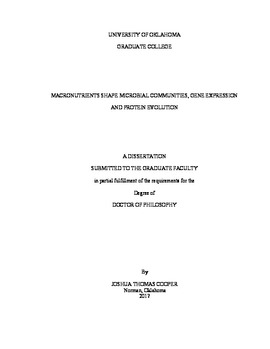| dc.description.abstract | Nutrient limitation of the principle macronutrients carbon, nitrogen and phosphorus are known to influence community structure, success of individual species, and over long enough time could, in theory, shape the evolution of proteins organisms use to cope with nutrient stress. This dissertation explores macronutrients incorporation into bacterial communities, how organisms modulate gene expression to cope with periodic nutrient stress, and how long-term limitation might shape cellular stoichiometry to reduce biochemical nutrient demand. In the first chapter, arctic natural microbial communities are investigated, and a strong seasonal shift of bacterial and archaeal N utilization from ammonium during the summer to urea during the winter is demonstrated via 15N-based stable isotope probing (SIP). In combination with collaborative 13C-bicarbonate based SIP studies, these data point to the potential for urea fueled nitrification as an important source of primary production during the arctic winter. The second chapter examines the nutrient limited transcriptome of a harmful bloom forming algae, Scrippsiella trochoidea CCMP 3099 to investigate its cellular response to nitrogen or phosphorus stress. Transcriptome data indicates that N limitation in S. trochoidea modulates gene expression to compensate for oxidative stress and appears to switch from inorganic nitrate metabolism to dissolved organic sources. The third chapter aims to understand how, over long time scales of phytoplankton and protists evolution, N limitation might alter the stoichiometry of the proteome to reduce overall nutrient utilization. It was tested whether the nutritional mode (autotrophy, mixotrophy, and heterotrophy) might be a predictor of the overall balance of macroelements in predicted protein products. The hypothesis that organisms living in more N limiting environments produce N-deplete protein products (based on side-chain chemistry), is rejected. Conversely, predicted proteins in the transcriptomes of mixotrophs appear enriched in amino acids with greater C content. The stoichiometry of the in silico translated proteome has a weak correlation to environmental nutrients (not significant for nitrate, but significant for phosphate). The last chapter is an extension of the primary research goals with respect to algal transcriptomes put forth in this dissertation. The chapter’s aim is to integrate scholarship and teaching by introducing cutting edge research results into a case study designed for introductory biology students to teach the central dogma of molecular biology in terms of genomics technologies. This chapter incorporates “Central Dogma of Molecular Biology”, “big data”, “cells as systems”, and the “flow of information” with societal issues and problem solving of the harmful bloom forming dinoflagellate Karenia brevis. | en_US |
